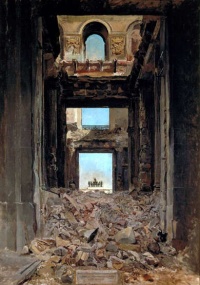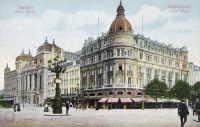Palace
From The Art and Popular Culture Encyclopedia
(Difference between revisions)
| Revision as of 20:18, 8 December 2023 Jahsonic (Talk | contribs) ← Previous diff |
Revision as of 20:19, 8 December 2023 Jahsonic (Talk | contribs) Next diff → |
||
| Line 1: | Line 1: | ||
| [[Image:Meissonier Ruins of the Tuileries.jpg|left|thumb|200px|''[[Ruins of the Tuileries]]'' ]] | [[Image:Meissonier Ruins of the Tuileries.jpg|left|thumb|200px|''[[Ruins of the Tuileries]]'' ]] | ||
| [[Image:The Crystal Palace.jpg|thumb|right|200px|[[The Crystal Palace]], built for the [[Great Exhibition]] of [[1851]], symbolizes the rise of [[modern architecture]] by its use of [[glass]] and [[steel]].]] | [[Image:The Crystal Palace.jpg|thumb|right|200px|[[The Crystal Palace]], built for the [[Great Exhibition]] of [[1851]], symbolizes the rise of [[modern architecture]] by its use of [[glass]] and [[steel]].]] | ||
| + | [[Image:Grand Hotel Weber.jpg|thumb|right|200px|[[Grand Hotel Weber]]]] | ||
| {{Template}} | {{Template}} | ||
| A '''palace''' is a grand [[residence]] where [[aristocrat]]s usually [[live]]. Other possible inhabitants include the home of a [[head of state]] or some other high-ranking [[public figure]]. In many parts of [[Europe]], the term is also applied to relatively large urban buildings built as the private [[mansion]]s of the [[aristocracy]]. Many historic palaces are now put to other uses such as [[parliament]]s, [[museum]]s, [[hotel]]s or [[office building]]s. The word is also sometimes used to describe a lavish public building which was never a [[residence]]; this use may be intended to convey that the building is a "[[people's palace]]", where a sort of [[civic]] consciousness resides. | A '''palace''' is a grand [[residence]] where [[aristocrat]]s usually [[live]]. Other possible inhabitants include the home of a [[head of state]] or some other high-ranking [[public figure]]. In many parts of [[Europe]], the term is also applied to relatively large urban buildings built as the private [[mansion]]s of the [[aristocracy]]. Many historic palaces are now put to other uses such as [[parliament]]s, [[museum]]s, [[hotel]]s or [[office building]]s. The word is also sometimes used to describe a lavish public building which was never a [[residence]]; this use may be intended to convey that the building is a "[[people's palace]]", where a sort of [[civic]] consciousness resides. | ||
Revision as of 20:19, 8 December 2023

The Crystal Palace, built for the Great Exhibition of 1851, symbolizes the rise of modern architecture by its use of glass and steel.
|
Related e |
|
Featured: |
A palace is a grand residence where aristocrats usually live. Other possible inhabitants include the home of a head of state or some other high-ranking public figure. In many parts of Europe, the term is also applied to relatively large urban buildings built as the private mansions of the aristocracy. Many historic palaces are now put to other uses such as parliaments, museums, hotels or office buildings. The word is also sometimes used to describe a lavish public building which was never a residence; this use may be intended to convey that the building is a "people's palace", where a sort of civic consciousness resides.
See also
Unless indicated otherwise, the text in this article is either based on Wikipedia article "Palace" or another language Wikipedia page thereof used under the terms of the GNU Free Documentation License; or on research by Jahsonic and friends. See Art and Popular Culture's copyright notice.



